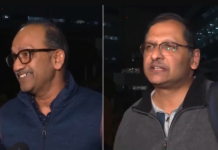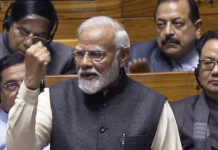The 2,000 banknote was introduced in November 2016 under Section 24(1) of the RBI Act, 1934, which allows the central bank to issue notes of any denomination not exceeding 10,000, primarily to meet the economy’s currency requirement “in an expeditious manner” following the big demonetisation exercise, in which the legal tender status of all 500 and 1,000 banknotes in circulation at the time was withdrawn, according to the Reserve Bank of India.
“With the achievement of that goal and the availability of banknotes in other denominations in adequate quantities, printing of 2000 banknotes was discontinued in 2018-19,” the RBI stated.
RBI Governor Shaktikanta Das stated today that the exercise is part of the central bank’s “currency management system” and that there is no need to haste.
RBI Governor Shaktikanta Das stated today that the effort is part of the central bank’s “currency management system” and that there is no need to rush to banks because consumers have four months to convert or deposit 2,000 notes.
Mr Das stated that the bank expects the majority of the notes to be returned. “After September 30, we’ll decide what to do.” But it will remain legal tender,” he added, assuring the public, even those residing in other nations, that the RBI will be sympathetic to all of their concerns.
Numbers of Rs 2,000 notes
The bulk (89%) of the 2,000 notes were issued before March 2017 and are nearing the end of their anticipated life expectancy of four to five years, according to the central bank, emphasising that 2,000 notes are not often used for transactions.
“The total value of these banknotes in circulation has declined from 6.73 lakh crore on March 31, 2018 (37.3% of Notes in Circulation) to 3.62 lakh crore on March 31, 2023, constituting only 10.8% of Notes in Circulation,” the RBI stated.
The RBI also stated that it has a enough supply of banknotes in various denominations.
What exactly is the “Clean Note Policy”?
The central bank’s “Clean Note Policy” has resulted in the withdrawal of Rs 2,000 notes. The RBI’s “Clean Note Policy,” implemented in 1999, aims to supply excellent quality currency notes and coins while removing filthy notes from circulation. The Reserve Bank then directed banks to provide only excellent quality clean notes to the public and to avoid from recycling filthy notes received over their counters.
Several other efforts were taken, including instructing banks to stop stapling note packets and instead bind the packets with paper/polythene bands to extend the life of currency notes. People were also advised not to scribble on the currency notes, and banks were told to provide unlimited exchange services for dirty and disfigured bills.
People were also advised not to scribble on the currency notes, and banks were told to provide unlimited exchange services for dirty and disfigured bills. According to Reserve Bank directives, currency chest offices of banks must supply acceptable quality notes and coins in exchange for dirty and damaged currencies, even to non-customers.
How the exchange facility will function
The State Bank of India, India’s largest public bank, reaffirmed Wednesday that no paperwork or slip will be necessary when exchanging or depositing 2,000 notes.
According to government officials, people can swap 2,000 rupee notes up to 20,000 times every day. A person must stand in a queue, and they may return and stand in the queue indefinitely.
They stated that a person must stand in a queue and that they may return and stand in the same queue after exchanging money. The top limit of 20,000 is set to provide operational ease and to prevent disrupting routine bank branch activity.
The exchange facility will be open from May 23 through September 30. According to NDTV, the RBI may extend the deadline to exchange or deposit the notes from September 30 if necessary, however even if somebody possesses a 2,000 note after the present deadline, it will remain a legitimate tender.
The RBI Governor stated that if the deadline had not been imposed for September 30, people would not have taken it seriously and swapped notes.












